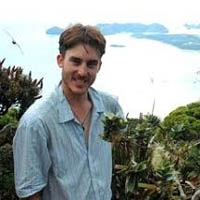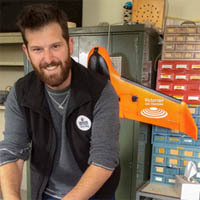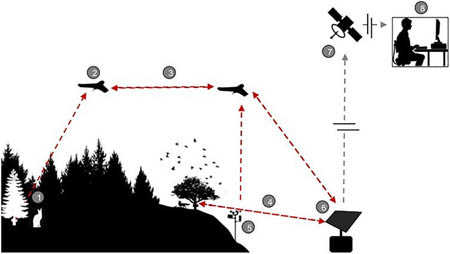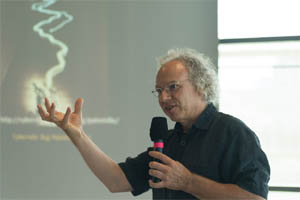
Content
Welcome to the Club of Amsterdam Journal.
The Future Now Show: Global Economy with Peter R Luiks hosted by Miss Metaverse
“The Future Now Show gets a personal opinion about the global economy; where it’s at, what’s coming next, but much more – you can’t talk about the global economy without including geopolitics, from what drives Russia and China, to immigration and the refugee crisis. Peter Luiks makes clear from the start that he is not one for political correctness, so strap yourself in.” – Paul Holister
Felix B Bopp, Founder & Chairman
From drone swarms to tree batteries, new tech is revolutionising ecology and conservation

By Euan Ritchie, Associate Professor in Wildlife Ecology and Conservation, Centre for Integrative Ecology, School of Life & Environmental Sciences, Deakin University, Australia and
Blake Allan, Deakin University
Understanding Earth’s species and ecosystems is a monumentally challenging scientific pursuit. But with the planet in the grip of its sixth mass extinction event, it has never been a more pressing priority.
To unlock nature’s secrets, ecologists turn to a variety of scientific instruments and tools. Sometimes we even repurpose household items, with eyebrow-raising results – whether it’s using a tea strainer to house ants, or tackling botfly larvae with a well-aimed dab of nail polish.
But there are many more high-tech options becoming available for studying the natural world. In fact, ecology is on the cusp of a revolution, with new and emerging technologies opening up new possibilities for insights into nature and applications for conserving biodiversity.
Our study, published in the journal Ecosphere, tracks the progress of this technological development. Here we highlight a few examples of these exciting advances.
Tiny tracking sensors
Electronically recording the movement of animals was first made possible by VHF radio telemetry in the 1960s. Since then even more species, especially long-distance migratory animals such as caribou, shearwaters and sea turtles, have been tracked with the help of GPS and other satellite data.
But our understanding of what affects animals’ movement and other behaviours, such as hunting, is being advanced further still by the use of “bio-logging” – equipping the animals themselves with miniature sensors.
Many types of miniature sensors have now been developed, including accelerometers, gyroscopes, magnetometers, micro cameras, and barometers. Together, these devices make it possible to track animals’ movements with unprecedented precision. We can also now measure the “physiological cost” of behaviours – that is, whether an animal is working particularly hard to reach a destination, or within a particular location, to capture and consume its prey.
Taken further, placing animal movement paths within spatially accurate 3D-rendered (computer-generated) environments will allow ecologists to examine how individuals respond to each other and their surroundings.
These devices could also help us determine whether animals are changing their behaviour in response to threats such as invasive species or habitat modification. In turn, this could tell us what conservation measures might work best.
Autonomous vehicles
Remotely piloted vehicles, including drones, are now a common feature of our skies, land, and water. Beyond their more typical recreational uses, ecologists are deploying autonomous vehicles to measure environments, observe species, and assess changes through time, all with a degree of detail that was never previously possible.
Coupling autonomous vehicles with sensors (such as thermal imaging) now makes it easier to observe rare, hidden or nocturnal species. It also potentially allows us to catch poachers red-handed, which could help to protect animals like rhinoceros, elephants and pangolins.
3D printing
Despite 3D printing having been pioneered in the 1980s, we are only now beginning to realise the potential uses for ecological research. For instance, it can be used to make cheap, lightweight tracking devices that can be fitted onto animals. Or it can be used to create complex and accurate models of plants, animals or other organisms, for use in behavioural studies.
Bio-batteries
Keeping electronic equipment running in the field can be a challenge. Conventional batteries have limited life spans, and can contain toxic chemicals. Solar power can help with some of these problems, but not in dimly lit areas, such as deep in the heart of rainforests.
“Bio-batteries” may help to overcome this challenge. They convert naturally occurring sources of chemical energy, such as starch, into electricity using enzymes. “Plugging-in” to trees may allow sensors and other field equipment to be powered cheaply for a long time in places without sun or access to mains electricity.
Combining technologies
All of the technologies described above sit on a continuum from previous (now largely mainstream) technological solutions, to new and innovative ones now being trialled.

Illustrative timeline of new technologies in ecology and environmental science. Source and further details at DOI: 10.1002/ecs2.2163. Euan Ritchie
Imagine research stations fitted with remote cameras and acoustic recorders equipped with low-power computers for image and animal call recognition, powered by trees via bio-batteries. These devices could use low-power, long-range telemetry both to communicate with each other in a network, potentially tracking animal movement from one location to the next, and to transmit information to a central location. Swarms of drones working together could then be deployed to map the landscape and collect data from a central location wirelessly, without landing. The drones could then land in a location with an internet connection and transfer data into cloud-based storage, accessible from anywhere in the world.

Visualisation of a future smart research environment, integrating multiple ecological technologies. The red lines indicate data transfer via the Internet of things (IoT), in which multiple technologies are communicating with one another. The gray lines indicate more traditional data transfer. Broken lines indicate data transferred over long distances. (1) Bio-batteries; (2) The Internet of things (IoT); (3) Swarm theory; (4) Long-range low-power telemetry; (5) Solar power; (6) Low-power computer; (7) Data transfer via satellite; and (8) Bioinformatics. Source and further details at DOI: 10.1002/ecs2.2163. Euan Ritchie
These advancements will not only generatemore accurate research data, but should also minimise the disturbance to species and ecosystems in the process.
Not only will this minimise the stress to animals and the inadvertent spread of diseases, but it should also provide a more “natural” picture of how plants, animals and other organisms interact.
Read more: ‘Epic Duck Challenge’ shows drones can outdo people at surveying wildlife
Realising the techno-ecological revolution will require better collaboration across disciplines and industries. Ecologists should ideally also be exposed to relevant technology-based training (such as engineering or IT) and industry placements early in their careers.
Several initiatives, such as Wildlabs, the Conservation Technology Working Group and TechnEcology, are already addressing these needs. But we are only just at the start of what’s ultimately possible.
Yanny or Laurel
“Yanny or Laurel” is an auditory illusion that became popular in May 2018. In the brief audio recording, 53% of over 500,000 people answered on a Twitter poll that they heard a man saying the word “Laurel”, while 47% reported hearing a voice saying the name “Yanny”.
MIT grad students explain why some people hear “Yanny” and others hear “Laurel” in the audio clip that’s taken the world by storm.
The Future Now Show
Shape the future now, where near-future impact counts and visions and strategies for preferred futures start. – Club of Amsterdam
Do we rise above global challenges? Or do we succumb to them? The Future Now Show explores how we can shape our future now – where near-future impact counts. We showcase strategies and solutions that create futures that work.
Every month we roam through current events, discoveries, and challenges – sparking discussion about the connection between today and the futures we’re making – and what we need, from strategy to vision – to make the best ones.
The Future Now Show
June 2018
with
Peter R. Luiks
hosted by
Miss Metaverse
“The Future Now Show gets a personal opinion about the global economy; where it’s at, what’s coming next, but much more – you can’t talk about the global economy without including geopolitics, from what drives Russia and China, to immigration and the refugee crisis. Peter Luiks makes clear from the start that he is not one for political correctness, so strap yourself in.” – Paul Holister
The Future Now Show
features

Energy Predictions – What Is The Future Of Energy?
Innovate UK
We’ve all heard of green energy, but what about smart energy? Thanks to new innovations, the future is looking brighter than ever.
The energy system of the future won’t look like today’s. The scale of change over the next 10 to 20 years will be considerable.
The main focus will be on local, low-carbon energy.
Thanks to the continuing rise of renewable energy like wind and solar power, the old economies of scale are being turned upside down so that generating and using energy locally will represent better value than the old system of generating energy at scale in relatively few, centralised, power plants.
Here are some of our predictions for the future of energy.
Decentralised energy and digital technologies
One of the major benefits of decentralised energy is the move away from inefficient large power stations to localised production, so that energy won’t have to travel so far.
Getting major energy users on board
The move to new, greener production and consumption of energy will only be successful if major consumers are also on board. It’s estimated that the cold chain in the UK currently consumes around 14% of all electricity generated, with food retailers operating massive networks of machines distributed throughout the UK.
Energy as a Service
To make energy part of the circular economy – where, rather than producing, using and disposing of resources, they are kept in use for as long as possible, recovered, regenerated and re-used – there will need to be a shift away from buying energy in kWh and towards buying energy as a service. This means that instead of consumers buying energy from a supplier, they pay a company to get energy at the best price, get the best value from the energy they generate, and improve the efficiency of their homes so that they use less energy.
Free energy?
It’s easier than ever for us to generate green energy. The cost of renewable generation equipment is coming down, and the amount of energy on the grid is going up – often to such levels that during sunny days or when there’s a lot of wind, there can actually be too much energy on the grid. The swings that this creates in wholesale prices can mean that prices can go ‘negative’, so that there is effectively ‘free’ energy on the grid.
Consumers at the heart
The biggest change of all is that consumers will go from being on the edge of the energy system to being at its heart. They will have more control over where their energy comes from, how and when they want to consume it, and can take an active role in making sure it doesn’t cost the earth.
News about the Future
Digital Weeding
Zasso Group specializes in weed and invasive plant control technologies by using high-voltage electric power.
Zasso destroys both the shoots and the even more critical roots of plants by employing advanced lightweight high-voltage methods. These powerful systems deliver safe and robust solutions without requiring any chemical agro-toxics – save for the environment, the infrastructure and human beings.
Specifically designed electric applicators run high-energy power through the whole plant, clearing targeted areas accurately within seconds and keeping them free of plants for months without any such side effects as
- chemical residues,
- chemical drift and resulting plant damages,
- soil erosion,
- damages to infrastructure caused by mechanical elimination.
An electronic rescue dog
ETH Zurich scientists have developed the smallest and cheapest ever equipment for detecting people by smell. It could be used in the search for people buried by an earthquake or avalanche.
A new measuring device from researchers at ETH Zurich led by Sotiris Pratsinis, Professor of Process Engineering, however, is always ready for use. The scientists had previously developed small and extremely sensitive gas sensors for acetone, ammonia, and isoprene – all metabolic products that we emit in low concentrations via our breath or skin. The researchers have now combined these sensors in a device with two commercial sensors for CO2 and moisture.
Oudebosch eco-cabins at Kogelberg Nature Reserve
AfriSam-SAIA Award for Sustainable Architecture and Innovation
Tucked away in an UNESCO World Heritage Site in the mountains above Betty’s Bay, Oudebosch Camp nestles unobtrusively within a protected wilderness area in the Kogelberg Biosphere in South Africa. The buildings are modestly scaled, lightweight, with planted roofs. The palette of natural, local, renewable, low embodied energy, non toxic materials and components develops the low impact sustainable qualities of the project. Low tech simple passive design principles underpin crafting of the building envelope which is shaped for the shifting seasons.
Recommended Book

The New Human Rights Movement:
Reinventing the Economy to End Oppression
by Peter Joseph
Society is broken. We can design our way to a better one.
In our interconnected world, self-interest and social-interest are rapidly becoming indistinguishable. If current negative trajectories remain, including growing climate destabilization, biodiversity loss, and economic inequality, an impending future of ecological collapse and societal destabilization will make “personal success” virtually meaningless. Yet our broken social system incentivizes behavior that will only make our problems worse. If true human rights progress is to be achieved today, it is time we dig deeper – rethinking the very foundation of our social system.
In this engaging, important work, Peter Joseph, founder of the world’s largest grassroots social movement – The Zeitgeist Movement – draws from economics, history, philosophy, and modern public-health research to present a bold case for rethinking activism in the 21st century.
Arguing against the long-standing narrative of universal scarcity and other pervasive myths that defend the current state of affairs, The New Human Rights Movement illuminates the structural causes of poverty, social oppression, and the ongoing degradation of public health, and ultimately presents the case for an updated economic approach. Joseph explores the potential of this grand shift and how we can design our way to a world where the human family has become truly sustainable.
The New Human Rights Movement reveals the critical importance of a unified activism working to overcome the inherent injustice of our system. This book warns against what is in store if we continue to ignore the flaws of our socioeconomic approach, while also revealing the bright and expansive future
What Plants Talk About
When we think about plants, we don’t often associate a term like “behavior” with them, but experimental plant ecologist JC Cahill wants to change that. The University of Alberta professor maintains that plants do behave and lead anything but solitary and sedentary lives. What Plants Talk About teaches us all that plants are smarter and much more interactive than we thought!
Futurist Portrait: Alexander Mankowsky

Alexander Mankowsky, Futures Studies & Ideation, Daimler AG
“Future Studies & Ideation as a working field requires explanation:
Future Studies normally results in reports made from scenarios about possible futures. Most often these futures are slightly dystopian or alarmist.
These reports then are thrown at business and government, with the request on ‘do something about it’, which is the reason for the alarmist undertone.
Personally I find this procedure boring and unsatisfying, even irresponsible.
To make more about it, I added the ‘& Ideation’, to show that after the insight in possible futures, the product should be a concept, developed together with creative people from many professions. Take some risk; get your hands dirty, that’s where the fun part begins.”






Customer Reviews
Thanks for submitting your comment!